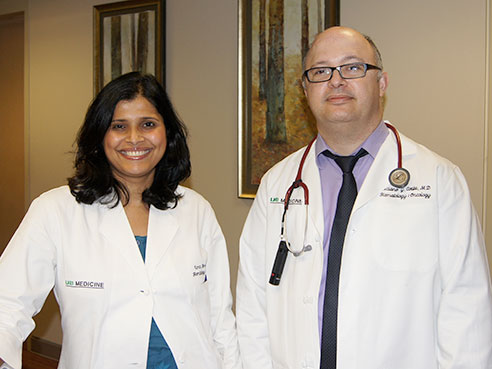 Uma Borate, left, and Luciano CostaA new University of Alabama at Birmingham study reveals that insurance status, marital status and county-level income may affect the chances of survival in young patients with acute myeloid leukemia.
Uma Borate, left, and Luciano CostaA new University of Alabama at Birmingham study reveals that insurance status, marital status and county-level income may affect the chances of survival in young patients with acute myeloid leukemia.
The findings, published online in Cancer, a peer-reviewed journal of the American Cancer Society, indicate that additional efforts and resources are needed to address the social factors that impact critical aspects of health in these patients.
The UAB study is the largest to date to look at socioeconomic factors in outcomes of younger patients with AML.
In 2015, AML will affect about 20,830 people in the United States, and 10,460 will likely die of the disease.
“A cure is possible mostly for younger patients; but treatment is intense, often requiring a bone marrow transplant and using a lot of resources from the health care system, patients and families,” said Luciano Jose Costa, M.D., Ph.D., associate professor in the UAB Division of Hematology and Oncology. “We have made tremendous progress in understanding the biology of AML. But we need to pay the same attention to resources available to our patients as this greatly impacts their chances to survive their leukemia.”
Investigators at UAB analyzed a database with 5,541 patients younger than the age of 65 to demonstrate that, in addition to age and disease characteristics, other “nonbiological” patient characteristics matter in having a higher or lower chance of cure.
| The research showed that patients who were single or divorced, patients who were uninsured or were Medicaid beneficiaries, and patients who lived in areas with lower income had substantially higher risk of death. |
The research showed that patients who were single or divorced, patients who were uninsured or were Medicaid beneficiaries, and patients who lived in areas with lower income had substantially higher risk of death.
The first and most immediate implication of these results relates to outcome analysis.
“We believe these three factors indicate lack of material and social support preventing young patients from successfully walking the long and difficult road toward cure,” said Uma Borate, M.D., assistant professor in the UAB Division of Hematology and Oncology and lead author of the study.
Costa and Borate, also scientists at the UAB Comprehensive Cancer Center, suggest that the findings show these factors, that are not necessarily related to care, can have significant impacts on AML patients’ outcomes.
“As physicians, we often emphasize more of the biology of the cancer, especially with the recent focus on personalized medicine,” said Costa, the senior author of the study. “But we need to pay the same attention to resources available to our patients, as this greatly impacts their chances to survive leukemia. By pointing to the factors that likely have nothing to do with biology as having a strong effect on survival of younger AML patients, this study reveals other opportunities to improve outcomes. The focus needs to change somewhat from the cancer to the cancer patient.”
This will be especially important as the United States transitions to a health care system that ties physician and hospital payments to patient outcomes.
“Taking from the results of this study, factors that have nothing to do with quality of care need to be accounted for when comparing predicted with actual outcomes,” Borate said. “Otherwise a disincentive for hospitals and doctors to care for less privileged patients may develop.”
